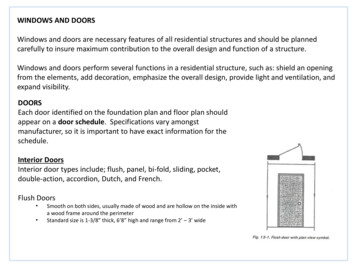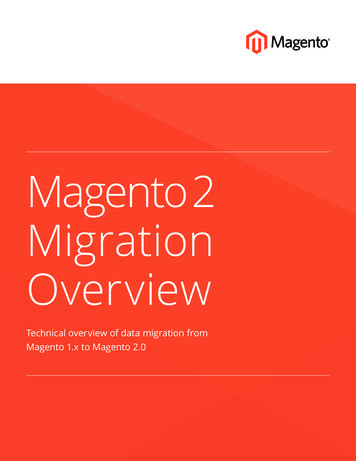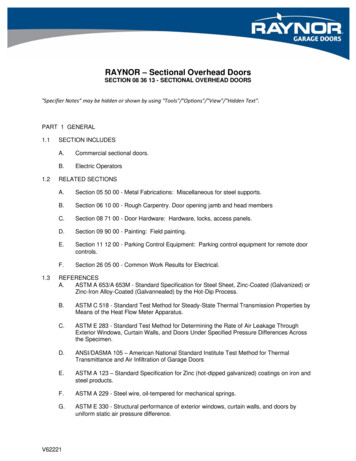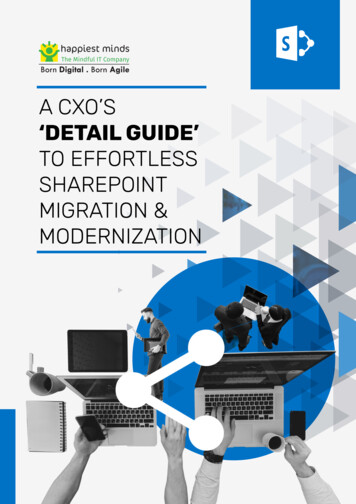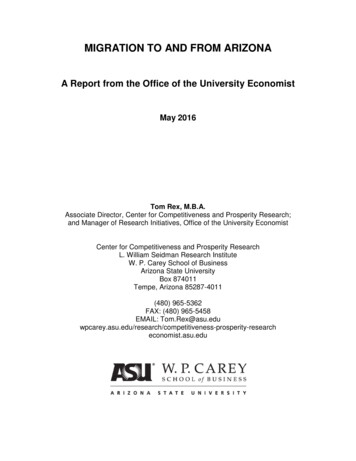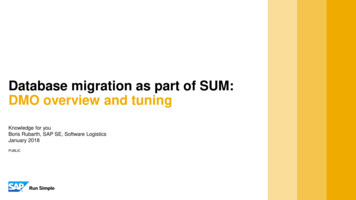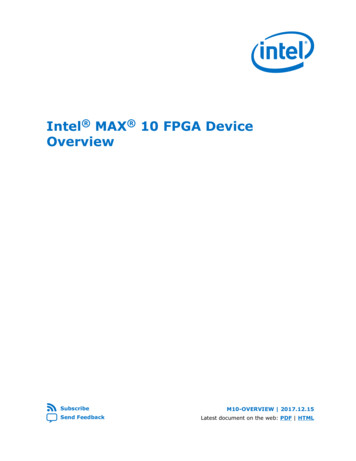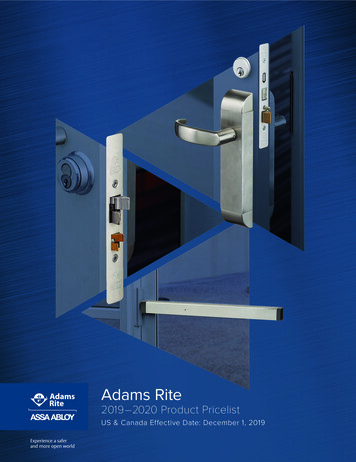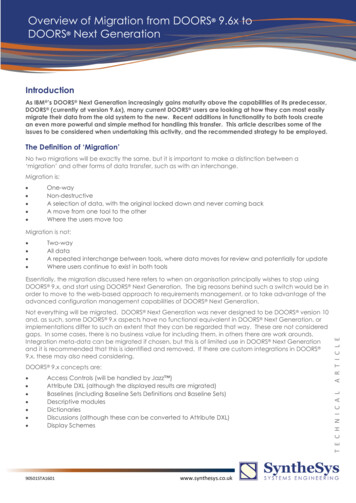
Transcription
Overview of Migration from DOORS 9.6x toDOORS Next GenerationIntroductionAs IBM ’s DOORS Next Generation increasingly gains maturity above the capabilities of its predecessor,DOORS (currently at version 9.6x), many current DOORS users are looking at how they can most easilymigrate their data from the old system to the new. Recent additions in functionality to both tools createan even more powerful and simple method for handling this transfer. This article describes some of theissues to be considered when undertaking this activity, and the recommended strategy to be employed.The Definition of ‘Migration’No two migrations will be exactly the same, but it is important to make a distinction between a‘migration’ and other forms of data transfer, such as with an interchange.Migration is: One-wayNon-destructiveA selection of data, with the original locked down and never coming backA move from one tool to the otherWhere the users move tooMigration is not: Two-wayAll dataA repeated interchange between tools, where data moves for review and potentially for updateWhere users continue to exist in both toolsDOORS 9.x concepts are: Access Controls (will be handled by Jazz )Attribute DXL (although the displayed results are migrated)Baselines (including Baseline Sets Definitions and Baseline Sets)Descriptive modulesDictionariesDiscussions (although these can be converted to Attribute DXL)Display Schemes90501STA1601www.synthesys.co.ukT E C H N I C A LNot everything will be migrated. DOORS Next Generation was never designed to be DOORS version 10and, as such, some DOORS 9.x aspects have no functional equivalent in DOORS Next Generation, orimplementations differ to such an extent that they can be regarded that way. These are not consideredgaps. In some cases, there is no business value for including them, in others there are work arounds.Integration meta-data can be migrated if chosen, but this is of limited use in DOORS Next Generationand it is recommended that this is identified and removed. If there are custom integrations in DOORS 9.x, these may also need considering.A R T I C L EEssentially, the migration discussed here refers to when an organisation principally wishes to stop usingDOORS 9.x, and start using DOORS Next Generation. The big reasons behind such a switch would be inorder to move to the web-based approach to requirements management, or to take advantage of theadvanced configuration management capabilities of DOORS Next Generation.
Recommended Approach DOORS partitionsDOORS project and module archives (i.e. DPA or DMA)DXLFavouritesFilters (although the migrated collection will show the expected result set)GroupsHistoryLayout DXL columns (although these can be converted to Attribute DXL)Link attributesLink modulesLinkset pairingsPage SetupsPredicate MappingsReqIF packagesShareable sectionsSoft-deleted data (i.e. deleted but not purged)SortsSuspicionTemplate files for Rational Publishing EngineTriggersUsers and user optionsWorking SetsThe Recommended ApproachExactly how a migration is completed will depend on the needs and priorities of the organisation inquestion. Broadly though, the process for completing a migration will break down into 4 distinct stages.In all cases, it is recommended that this process is done incrementally rather than in a ‘big bang’ event.The move to DOORS Next Generation will require users to be retrained, and a ramp-up of the newsystem and a ramp-down of the old will ensure a smooth transition from one to the other.90501STA1601www.synthesys.co.ukT E C H N I C A LA R T I C L EFirst though, it needs to be decided exactly which parts of the current DOORS 9.x database will bemigrated. In order to reduce effort and minimise cost and risk, only a relevant subset of data in thecontext of the business need will be migrated. This subset should focus on current and future work thatwill benefit from the capabilities offered by DOORS Next Generation, and should not include historical orcompleted projects. DOORS is never going to reach version 10, but still has a long life ahead of it and isnot going anywhere for the foreseeable future. For that reason, it is strongly recommended that historicaldata and project audit trails up to the point of migration are kept in DOORS 9.x.
Analysis & Preparation 1. AnalysisPreparationIn the same way that product development can benefit from the ‘left shift’ approach, time invested inpreparation improves the quality of migrated data. This is going to be invested in several activities: Remove soft deleted artefactsConsolidate attributesConsolidate attribute typesConsider adding an ‘artefact type’ attribute if it does not exist and organising objects accordingly90501STA1601www.synthesys.co.ukT E C H N I C A L2.A R T I C L EThe subset of data needs to be analysed to understand the shape and size of the source data, and thento identify potential risk areas and possible process improvements. Using the new ‘Migration’ menu,metrics for the selected data set can be produced in CSV and XML files. When loaded into Excel, theformer shows which modules each attribute is used in, and the types of attributes, allowing us to see thediversity across the data set. The latter allows us to put the data into a tabulated format. This is the onlyphase which should be done all in one go; the later phases can be done incrementally.
Execution3.ExecutionAt this point, having a consolidated, tidy subset of data means that the actual transfer should berelatively painless. The steps for the process break down like this:Create a new migration packageChoose the (formal) modules to be transferred, and add them to the package. (Links areautomatically selected as required, so link modules do not need to be added.) The wizard will show that the package has not been exported. At this point we select ‘ExportPackage’. What is exported is technically a ReqIF package, but has been optimised to containextra information relating to things such as DOORS tables, OSLC links, and some specificmigration attributes90501STA1601www.synthesys.co.ukT E C H N I C A L A R T I C L EIn DOORS 9.x:
ExecutionThe package (and modules within it) will show as ‘Exported’ – data is there in a read-only state.Now we need to physically move the package to the destinationT E C H N I C A LA R T I C L E 90501STA1601www.synthesys.co.uk
ExecutionIn DOORS Next Generation: Once the package is uploaded for processing and the steps in the wizard have been completed,a report is produced confirming the resultsT E C H N I C A LA R T I C L E Create a new, blank project. As we will be harvesting many of the project properties from thepackage, there is no need to establish artefact typesChoose the option to ‘Import requirements from a migration package’90501STA1601www.synthesys.co.uk
ExecutionIncluded in the imported data are the DOORS URI, DOORS Object ID and the Link dataT E C H N I C A LA R T I C L E 90501STA1601www.synthesys.co.uk
Post Processing4.Post-ProcessingAbout SyntheSysSyntheSys provides defence systems, training, systems and software engineering and technical management services over a spectrum ofdifferent industry sectors. Along with distinct support and consultancy services, our innovative product range makes us first choice provider forboth large and small organisations. Established in 1988, the company focus is on fusing technical expertise with intuitive software applicationsto solve common industry challenges.90501STA1601www.synthesys.co.ukT E C H N I C A LA R T I C L EPotentially, additional work can be done here to tidy up the type system and module structure ifnecessary. Once the data is reviewed, it is possible that process may need to be adapted to leveragethe new functionality in DOORS Next Generation.
9.x, and start using DOORS Next Generation. The big reasons behind such a switch would be in order to move to the web-based approach to requirements management, or to take advantage of the advanced configuration management capabilities of DOORS Next Generation. Not everything will be migrated. DOORS. Next Generation was never designed .

